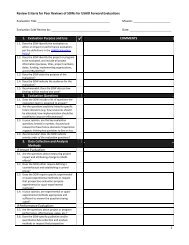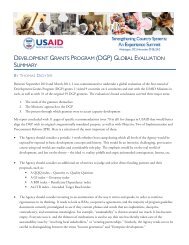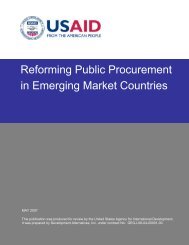Study on USAID Non-Project Assistance Programs in
Study on USAID Non-Project Assistance Programs in
Study on USAID Non-Project Assistance Programs in
Create successful ePaper yourself
Turn your PDF publications into a flip-book with our unique Google optimized e-Paper software.
10.2 PROGRAM IMPLEMENTATION<strong>USAID</strong> should not underestimate the management burden associated with NPA. This burden<strong>in</strong>creases as layers of adm<strong>in</strong>istrati<strong>on</strong> and track<strong>in</strong>g are added to disbursement mechanisms.Complex policy reform agendas add to the management burden by impos<strong>in</strong>g c<strong>on</strong>siderabledemands <strong>on</strong> the Missi<strong>on</strong> to m<strong>on</strong>itor host government progress aga<strong>in</strong>st those agendas. It shouldbe remembered that this management burden is also shared by the host government <strong>in</strong>stituti<strong>on</strong>s<strong>in</strong>volved <strong>in</strong> the program and may serve to dim<strong>in</strong>ish enthusiasm for the NPA policy reformagenda.NPA is <strong>in</strong>tended to be a mechanism for the quick disbursement of funds, as a means of provid<strong>in</strong>gbudgetary support to a nati<strong>on</strong>al treasury or sector. The end use of the funds is not (or is <strong>on</strong>ly loosely)def<strong>in</strong>ed, and little track<strong>in</strong>g of the end use of the funds is anticipated. As such, it should <strong>in</strong>cur m<strong>in</strong>imalmanagement demands <strong>on</strong> the Missi<strong>on</strong> <strong>in</strong>volved. As the health sector NPAs described here have departedfrom this orig<strong>in</strong>al "management lite" approach and imposed additi<strong>on</strong>al complexity <strong>in</strong> requirements for theuse of grant funds, or complexity <strong>in</strong> the policy reform agendas they c<strong>on</strong>ta<strong>in</strong>, the management burden has<strong>in</strong>creased substantially.In the case of Niger, the NPA design imposed a complicated (and ultimately problematic)<strong>in</strong>stituti<strong>on</strong>al structure that required the collaborati<strong>on</strong> of several m<strong>in</strong>istries and the <strong>USAID</strong> missi<strong>on</strong> toprogram and track NHSSG funds after disbursement. This was <strong>in</strong>tended to target those funds towardMissi<strong>on</strong> priority programs <strong>in</strong> the area of primary care and child survival. This mechanism, however,proved to be cumbersome, time c<strong>on</strong>sum<strong>in</strong>g and, <strong>in</strong> the f<strong>in</strong>al analysis, <strong>in</strong>effective <strong>in</strong> facilitat<strong>in</strong>g the flowof funds. The process suffered from a lack of clear def<strong>in</strong>iti<strong>on</strong> of the desired uses for the funds and theprocedures by which they were to be allocated. The account<strong>in</strong>g procedures and capabilities of the<strong>in</strong>stituti<strong>on</strong>s <strong>in</strong>volved were <strong>in</strong>adequate, and the secretariat created to facilitate transfer of funds, wasdecertified by <strong>USAID</strong>. The operati<strong>on</strong> of the secretariat, procedures for the allocati<strong>on</strong> of funds and track<strong>in</strong>guse of funds c<strong>on</strong>sumed c<strong>on</strong>siderable amounts of time and energy with<strong>in</strong> the Missi<strong>on</strong>. In the end, theseproblems limited the budgetary impact of the NPA program.The mechanisms employed for the transfer of NPA funds <strong>in</strong> Kenya and Nigeria were lessburdensome. In Kenya, some time and effort (and c<strong>on</strong>sultati<strong>on</strong> with host government) was required toestablish the methodology by which the Government of Kenya would dem<strong>on</strong>strate to <strong>USAID</strong> that grantfunds had <strong>in</strong>creased the level of budget support to the M<strong>in</strong>istry of Health. The c<strong>on</strong>cept of additi<strong>on</strong>alityof NPA funds to exist<strong>in</strong>g health resources, compared to substituti<strong>on</strong>, was a key facet of the KHCFprogram design.The three NPA programs described here all c<strong>on</strong>ta<strong>in</strong> complex policy reform agendas. It has beennecessary for <strong>USAID</strong> missi<strong>on</strong>s <strong>in</strong> each of the three countries to expend c<strong>on</strong>siderable effort to m<strong>on</strong>itor hostgovernment progress toward meet<strong>in</strong>g the policy reform benchmarks. In all three cases this has requiredmuch more effort than anticipated by the Missi<strong>on</strong>. In Niger and Kenya much of this burden was/has beentransferred to the technical assistance team. The team’s participati<strong>on</strong> <strong>in</strong> assist<strong>in</strong>g <strong>USAID</strong> to m<strong>on</strong>itor hostcountry success toward meet<strong>in</strong>g benchmarks has had a generally negative impact <strong>on</strong> the positi<strong>on</strong>, role, andeffectiveness of the technical assistance team as resources to the M<strong>in</strong>istry of Health. In Nigeria, wherethere were no technical assistance resources available, the m<strong>on</strong>itor<strong>in</strong>g of FMOH progress by the <strong>USAID</strong>missi<strong>on</strong> proved to be problematic.36







